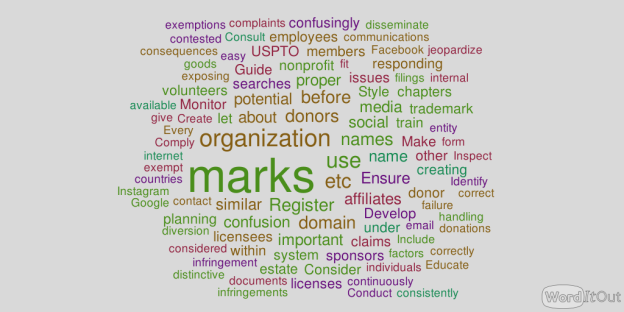1. Conduct professionally-assisted trademark searches before adopting new marks. Choose distinctive protectable marks. Make sure domain names are available for the marks before choosing them. Register marks with the USPTO. Consider registering the marks in other countries as well. Ensure the marks are applied for and registered in the name of your organization and not individuals within the organization. Comply with the requirements to maintain those marks. Adopt a system to ensure all of the organization’s marks remain continuously in use.
2. Register important domain names. Don’t let the organization’s important domain name registrations lapse for failure to renew or re-register.
3. Register important social media account names on Facebook, Twitter, Instagram, etc. Develop policies and rules for social media posts made on behalf of the organization.
4. Learn the basics about trademarks and train employees, volunteers, members, chapters, licensees, affiliates, sponsors etc., about the proper use of the organization’s marks. Use the proper symbols (TM, SM, or ®) next to the organization’s marks. Consider creating a Style Guide showing how to use the organization’s marks consistently and in the proper form. Every nonprofit organization should at least have a simple Style Guide.
5. Don’t allow employees, volunteers, members, chapters, licensees, affiliates, sponsors, etc., to register the organization’s marks (or confusingly similar marks).
6. Monitor USPTO filings, social media channels, and the internet (set Google Alerts, do periodic searches, check for domain names, etc.) for use of the organization’s marks (and confusingly similar marks). Develop an internal system for handling issues of potential infringement. Listen and watch for diversion of donations or confusion as shown by misdirected email, mail, complaints, donor communications, and donor patterns. Identify and train personnel to recognize signs of potential confusion.
7. Educate donors, potential anonymous donors, and those who advise them (estate planning attorneys etc.) about the organization’s correct name, so donors don’t write checks to or leave bequests to the “Animal Shelter” – thus creating ambiguity and exposing the organization to contested claims. Create and disseminate materials that help planned-giving participants correctly name the organization in their estate planning documents. Make it easy for donors and their advisors.
8. Require written signed licenses from affiliates and other third parties who will use the organization’s marks. Ensure the licenses put appropriate limits on how the marks can and cannot be used. Include terms under which the license can be terminated. Inspect and monitor the quality of goods and/or services provided under the marks.
9. Consult with knowledgeable nonprofit entity counsel to assure licensing, sponsorship, co-ventures, cause marketing, and related activities fit within recognized exemptions and do not give rise to undesired tax consequences or jeopardize the organization’s exempt status.
10. If the organization receives a cease-and-desist letter alleging trademark infringement or other claims, contact an attorney before responding. Priority of use, registration, public relations, confusion factors, and other issues must be reviewed and considered before responding. Disputes often can be resolved short of a lawsuit.

